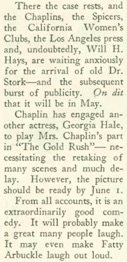The Gold Rush 1923 1924 1926 next previous
The Gold Rush Clippings 145/363
New Yorker, New York, March 21, 1925.
Lillita Louise Chaplin, Plaintiff, vs Charles Spencer Chaplin
(...) Divorce Papers, Los Angeles 1927,
AlexanderSanchez-Cabello/ParadeAntique/BNPS
„The childishly innocent victim of a rapacious roué“
Editorial content. „Home Problems in Hollywood
CHARLIE CHAPLIN is in trouble again.
Over his head hangs a sword that was forged in the
Californian sunshine of the cold metal that
entered the souls of the native sons when they lived
in Kansas, Iowa and Nebraska. It is the sword
of righteousness, the flaming blade of moral indignation.
It seems that Mr. Chaplin‘s home life has
been a trifle irregular – and irregularity in Los Angeles,
the City of Homes, is unpardonable. As the
newspapers have already indicated, a moderately interesting
– but to whom? – event is expected in the old
Chaplin manse, and when that event occurs, the sword will
descend with a glittering flash and the head that
wears the battered derby may roll into the basket of oblivion
Chaplin, according to present plans, is to be
driven out of the movies, out of the Golden State, into the hazy
limbo beyond the Sierras. That way lies Fatty
Arbuckle....
When was producing The Kid, six years ago, he engaged
for a minor rôle in that picture a young girl named
Lilita McMurray. The girl payed the bad angel in the dream
scene wherein Charlie himself fluttered through
Heaven, and her mother, for some reason, was named
Mrs. Lillian Spicer.
Mrs. Spicer, casting envious eyes at Jack Coogan, pere,
who had leaped to fame and fortune through the
activities of his offspring in The Kid, went to Chaplin and asked
that something be done for her gifted little
girl. Chaplin promised vaguely to do something.
At this point comes a series of explanatory subtitles
to indicate the passage of a period of five years.
Chaplin, casting for his newest picture, The Gold Rush,
engaged Mrs. Spicer‘s gifted girl (now known
as Lita Grey) as his leading woman. And so, last November
he entrained suddenly for Guyamas, Mexico, and
married her.
The details of this happy event were clouded with much
secrecy. (It was known, however, that Chaplin‘s best
man, who journeyed madly across the continent to stand by his
pal‘s side at the joyous happening, was Nathan
Burkan, New York theatrical lawyer.) No previous word of it was permitted to become known and consequently, when
the prospective bridegroom set out for Guyamas, he found
no more than seven Los Angeles newspapermen
in the same car. These reporters watched him closely, but
he finally outguessed them: the ceremony was
performed at four a. m. the next day, and Mr. and Mrs. Chaplin
were on their way home before the local Brouns
had arisen.
–
LATER the reporters besieged the Chaplin
residence and were thrown out by the squire – just like
so many Keystone cops.
This understandable, but ill-advised act, constituted
an affront to American journalism, as represented
by the Los Angeles Times, Examiner, and News, and Chaplin
suffered for it. Dark rumors were circulated as to the
military nature of his wedding and Miss Grey was pictured
as the childishly innocent victim of a rapacious roué.
These stories were called to the attention of the California
Women‘s Clubs, whose members, fulfilling their
obligation to civilization, proceeded to pass some resolutions.
Charlie Chaplin‘s pictures were to be boycotted.
Chaplin himself was declared leprous and unfit to associate
with decent people.
Sid Graumann, proprietor of the most important movie
parlors In the Los Angeles district, had booked
The Gold Rush for a long run at his Egyptian Theatre.
Representatives of the women‘s clubs went
straight to Mr. Graumann and told him, in effect, that he would
do well to change his mind. Mr. Graumann, staunch
old showman that he is, did well, changed his mind, and
cancelled the booking.
In the meantime, Mrs. Chaplin had installed herself
in her new home and was playing hostess to her
mother, her father, her grandmother, her grandfather, her uncle,
her aunt and several unidentified cousins. Mr. Chaplin
had moved out and was living in the Hollywood Athletic Club.
Negotiations for a settlement were soon under way.
Chaplin offered $250,000. Mrs. Spicer refused this, explaining
that her daughter‘s honor was worth $500,000, if it was
worth a nickel. Chaplin balked.
Finally the bickering ceased. Chaplin summarily
dismissed his wife‘s relations from his home – and returned
to live there himself.
There the case rests, and the Chaplins, the Spicers,
the California Women‘s Clubs, the Los Angeles
press and, undoubtedly, Will H. Hays, are waiting anxiously
for the arrival of old Dr. Stork – and the subsequent
burst of publicity. On dit that it will be in May.
Chaplin has engaged another actress, Georgia Hale,
to play Mrs. Chaplin‘s part in The Gold Rush –
necessitating the retaking of many scenes and much delay.
However, the picture should be ready by June 1.
From all accounts, it is an extraordinarily good comedy.
It will probably make a great many people
laugh. It may even make Fatty Arbuckle laugh out loud.“
The Gold Rush opens June 26, 1925 at
Grauman‘s Egyptian, 6712 Hollywood Bld., L. A.
Redaktioneller Inhalt
The Gold Rush 1923 1924 1926 next previous









